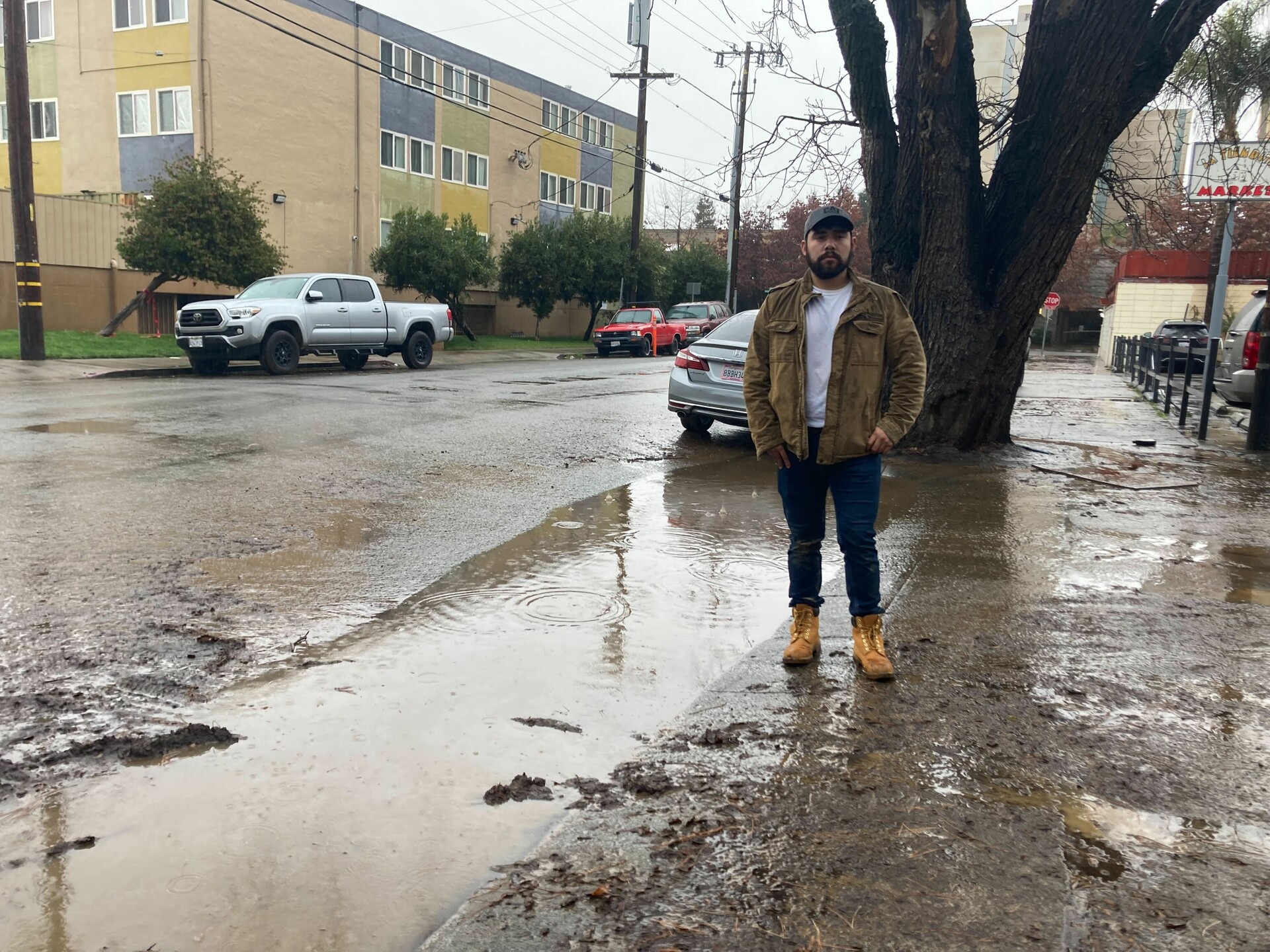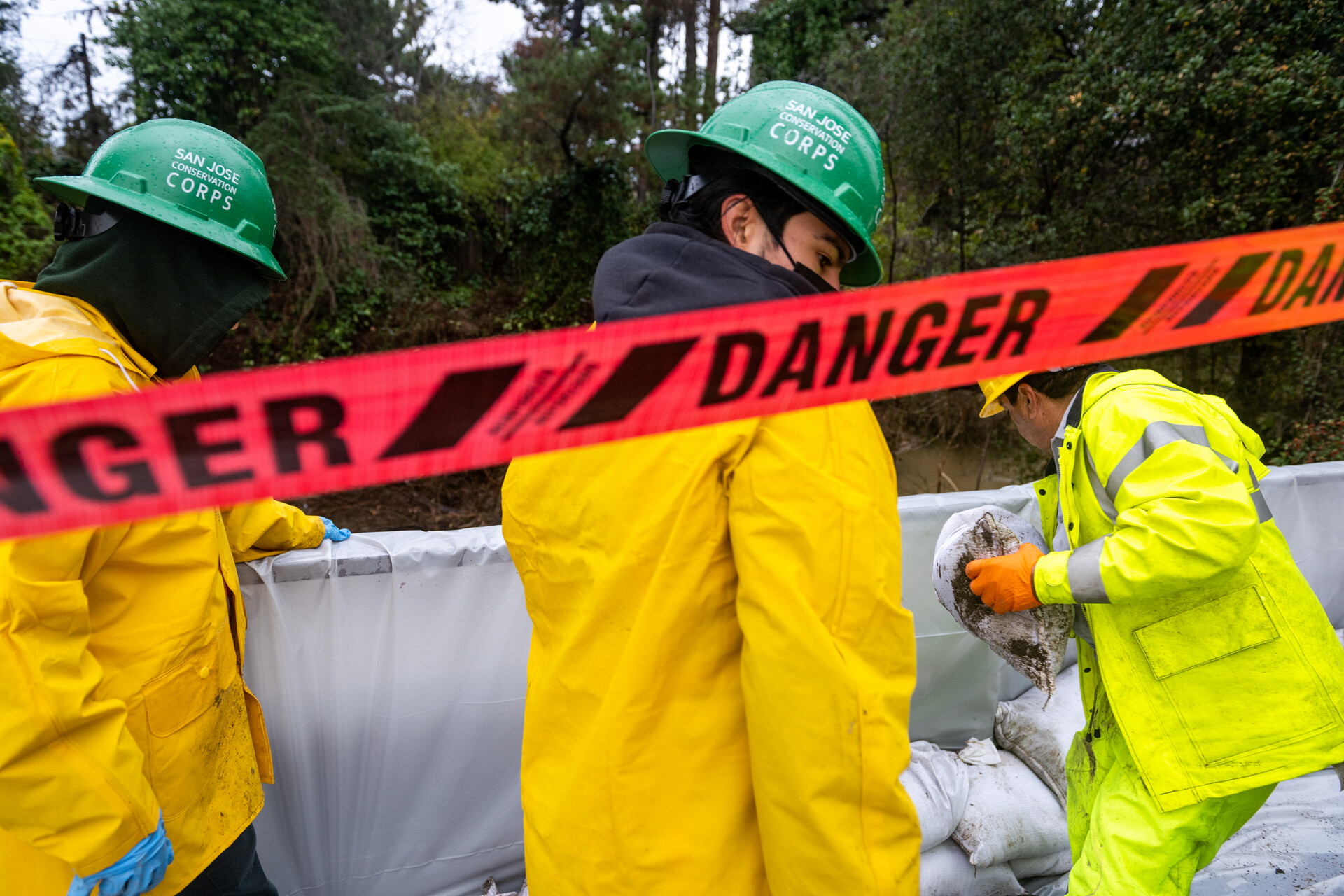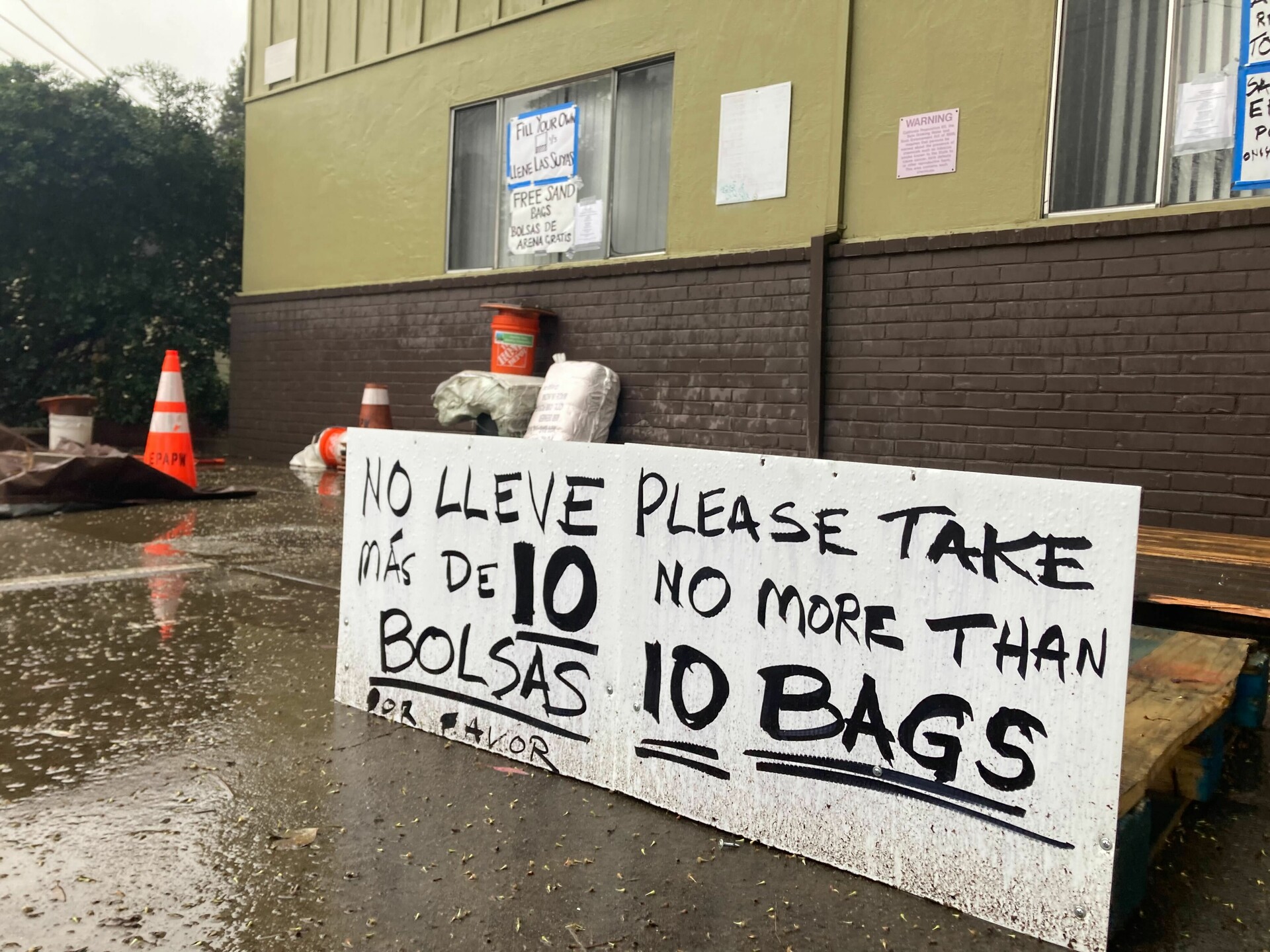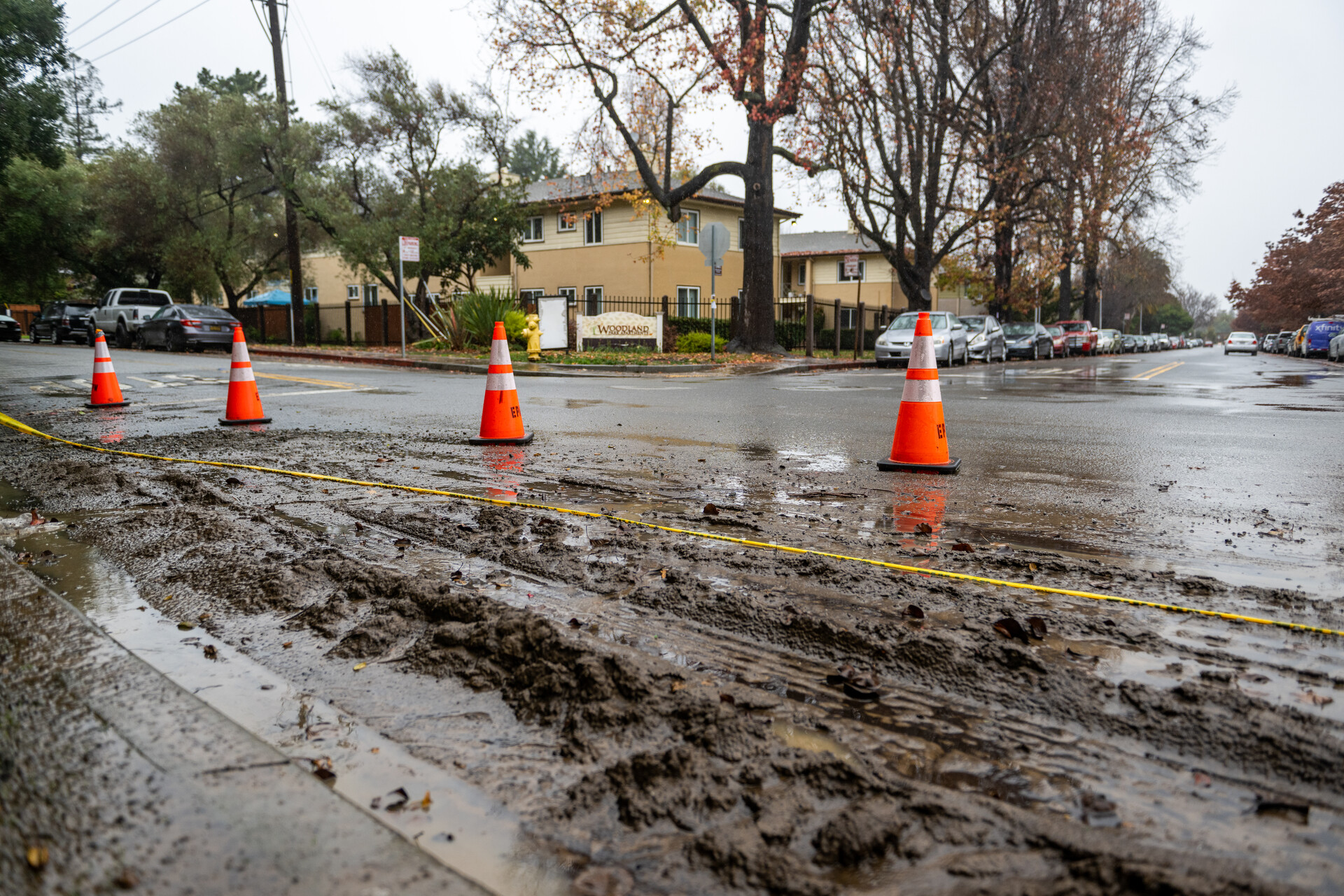Crews from East Palo Alto and the U.S. Army Corps of Engineers built a 3-foot-tall and several-hundred-yard-wide sandbag wall to keep the rising water out of the neighborhood as more atmospheric river storms threatened the city.
The temporary fix successfully kept the mushrooming creek from again inundating the community of mostly lower-income renters.
“The silver lining is it has certainly been a wake-up call,” López said. “A few pounds of sand separates us from flooded parking garages in Silicon Valley. I don’t feel so proud about that. It’s insufficient.”
Early estimates from the city and community groups are that flooding caused more than $100,000 worth of damage. This includes totaled cars, tools and other personal belongings stored in trunks and in low-lying garages. Marisela Ramos, president of the East Palo Alto West Side Neighborhood Committee, is organizing residents seeking outside aid to help pay for damages.
 Antonio López, East Palo Alto’s vice mayor, stands next to floodwaters in the city. (Ezra David Romero/KQED)
Antonio López, East Palo Alto’s vice mayor, stands next to floodwaters in the city. (Ezra David Romero/KQED)
“The cars were their means of transportation to go to work and to generate money to pay their rent for their children’s food,” she said. “They lost basically everything because, without transportation, it is very hard to make a living.”
She said most of the residents did not have flood insurance and are struggling to get aid. Ramos questions whether the flooding amounts to negligence by the city, landlords or the authorities who manage the creek.
“Why didn’t they act before to prevent this?” she asked. “This happened before. So, why didn’t they put protection on the banks of the creek before the storm?”
East Palo Alto has flooded many times over the years. In 1998 a flood of record swamped 1,700 properties, causing more than $28 million in damages.
The city is applying for a grant from the Silicon Valley Community Foundation to compensate for the damages, but it’s a slow process.
San Mateo County homeowners and renters with damage or losses from the storms can apply for federal disaster assistance, including grants to pay for temporary housing, transportation, child care and moving expenses. The deadline to apply for aid is March 15, 2023.
“This will be of great help to individuals and business owners who suffered losses during the severe storms that dumped 13 inches of rain on the county in December and January,” said U.S. Rep. Kevin Mullin, who represents East Palo Alto, in a release.
 Members of the San José Conservation Corps pile sandbags along the San Francisquito Creek in East Palo Alto on Jan. 4, 2023. The creek spilled over its banks and into a nearby community during the storm on Dec. 31. (Beth LaBerge/KQED)
Members of the San José Conservation Corps pile sandbags along the San Francisquito Creek in East Palo Alto on Jan. 4, 2023. The creek spilled over its banks and into a nearby community during the storm on Dec. 31. (Beth LaBerge/KQED)
Climate change means a wetter future
According to a new study published in the journal Nature Climate Change, atmospheric river storms — monster storms that form over the ocean and flow inland — will only get more intense. The wettest winter storms could become around 30% wetter by mid-century.
“The precipitation will be more intense, which is important because it can cause flash floods,” said Ruby Leung, study co-author and climate scientist at the Pacific Northwest National Laboratory.
She added that the atmospheric river storms would do more than engorge small creeks, also challenging the capacity of larger streams and rivers, especially when infrastructure like levees, freeways or bridges surround them. Waterways that used to sprawl into large marshy areas are now contained into managed stretches with limited capacity; larger storms are expected to bring more water than they can contain.
“The information we used before to design infrastructure may not be relevant anymore, and we need to incorporate the knowledge that we now have about how the future may be changing,” she said.
A renewed call to action for East Palo Alto
East Palo Alto council member Ruben Abrica lived through the 1998 storm.
He said bolstering the flood protection system for this community of more than 90% people of color is worth the investment.
“Climate change is going to affect everyone, but the most vulnerable communities are the ones that will suffer the most unless we join together,” he said.
Reducing the flood risk along this meandering waterway is what Margaret Bruce also mulls over daily as the executive director of the San Francisquito Creek Joint Powers Authority.
“We know we can’t completely do away with the risk of flooding,” she said. “We can no longer plan our future looking in the rearview mirror. But looking forward is very difficult to foresee.”
 A sign posted in East Palo Alto during a three-week stretch between December 2022 and January 2023, when nine atmospheric river storms pummeled California. (Ezra David Romero/KQED)
A sign posted in East Palo Alto during a three-week stretch between December 2022 and January 2023, when nine atmospheric river storms pummeled California. (Ezra David Romero/KQED)
Her group is leading a creek restoration project from the San Francisco Bay to the mouth of Searsville Dam.
The project has multiple parts. The agency finished the first reach in 2019, which should protect more than 1,700 properties from the bay to Highway 101 from a 100-year creek flood during a king tide event, plus 3 feet of sea level rise. Compared to today’s high tide, all the work would give the first section 10 feet of protection from rising tides.
The second reach, Highway 101 to the Pope-Chaucer Bridge, is the portion that recently flooded along the borders of East Palo Alto, Palo Alto and Menlo Park. The plan is to widen the channel and replace the bridge with a new one allowing more water to pass under it, protecting the community from a 100-year flood event.
It’s tentatively scheduled to be completed sometime between 2024 and 2026.
The one big issue in completing the project is how to fund it. Bruce said it would cost at least $50 million to restore about a mile of the creek. State or federal infrastructure dollars could help with this effort; otherwise, the partners that make up the authority — East Palo Alto, Menlo Park, Palo Alto, San Mateo County and the Santa Clara Valley Water District — are on the hook to get it finished.
The third reach, the rest of the watershed from the recently flooded area to Searsville Dam, is very much in its formative stage. Officials would like to create holding reservoirs along the creek’s upper stretch to store water during a storm.
“We don’t know yet if it’s going to be completely feasible,” Bruce said. “It may be so disruptive, costly or technically difficult that we’ll want to think twice about it. But we are considering it.”
Even further upstream, at Searsville Lake, Stanford University is designing a project to reestablish creeks flowing from the lake. The reservoir holds only about 10% of its original capacity because it has slowly filled with earth.
The university, which owns the dam, wants to create a tunnel gate at its base, establishing water channels to other creeks off the lake, increasing storage capacity by flushing sediment into San Francisquito Creek and then out to the bay. But this would only go into operation after the downstream reaches are finished.
The project could free up the reservoir to hold more water during storms to be released after the creek recedes; the state is reviewing its design and environmental impact analysis.
“Instead of having the creek as a boundary, the creek has ended up being the thing that joins the counties and these three cities,” Bruce said.
 Mud on the edge of Woodland Avenue along the San Francisquito Creek in East Palo Alto on Jan. 4, 2023. The creek spilled over its banks and into a nearby community during the storm on Dec. 31. (Beth LaBerge/KQED)
Mud on the edge of Woodland Avenue along the San Francisquito Creek in East Palo Alto on Jan. 4, 2023. The creek spilled over its banks and into a nearby community during the storm on Dec. 31. (Beth LaBerge/KQED)
‘Everybody’s paying attention’
The levee reconstruction and creek restoration along the lower stretch of the waterway significantly reduced the damage that could have happened in this set of atmospheric river storms.
Still, the flooding “puts the spotlight on all of us to somehow find the money one way or another, even if we have to beg the president or talk to the governor,” said East Palo Alto council member Abrica. “You can’t just say it’s your problem down there. Because then you condemn the poor communities to be flooded.”
Palo Alto and Menlo Park are taking an active role in the creek restoration. The recent storms flooded parts of Menlo Park, said Nikki Nagaya, the city’s deputy manager.
“We saw the creek levels spike throughout the lower section in Menlo Park, and we saw some overtopping in that area as well,” she said.
While the recent storms are a precursor of what’s to come in a warming world, Nagaya said she isn’t sure the project can be sped up.
“I think it will hopefully be a renewed call to action,” she said. “Everybody’s paying attention and wanting to see the work proceed as quickly as possible.”




















